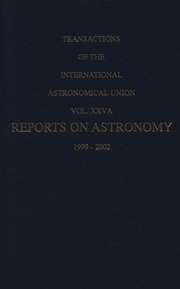No CrossRef data available.
Article contents
Structure and Evolution of the Galactic System
Published online by Cambridge University Press: 16 November 2021
Extract
The Galaxy in which we live is composed of three ingredients: stars, interstellar gas and cosmic rays.
The bulk of the mass is in the stars. A fair estimate can now be made of the amount of gas. It is probably between 5 and 10% of the total mass of the system.
The cosmic ray particles have a negligible mass density, but a considerable energy density, comparable to the kinetic energy of the interstellar gas. Their velocities are so high that they would leave the system in a time of the order of 100 000 years if they were not constrained by magnetic fields. The current theory is that cosmic rays, except for some rare particles with exceptionally high energies, are kept in the Galactic System by magnetic fields. As the latter are frozen in the interstellar gas, the cosmic rays exert a pressure on this gas and may thus influence its motion and distribution.
- Type
- Invited Discourse C
- Information
- Transactions of the International Astronomical Union , Volume 12 , Issue 1: Reports on Astronomy , 1965 , pp. 789 - 809
- Copyright
- Copyright © Academic Press 1965


